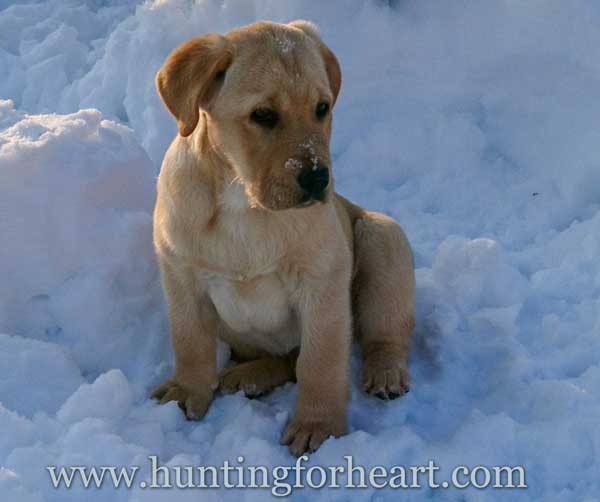Bringing Home a New Puppy
by Ellen Landauer
Bringing home a new puppy: supplies you need and how to embark on an extrordinary relationship!

Keeping your baby pup safe, beginning to integrate them into your life, and laying groundwork for the most profound bond you ever experienced with a dog - is the subject of this article.
In the avalanche of information on starting life with your canine companion, there is much misinformation and missing information. Here, you will find valuable guidance to point the way.
When bringing home a new puppy, some research and planning will help you make the best choice for transporting them.
Bringing Home a New Puppy:
Modes of Transportation
Supplies needed for bringing home a new puppy: water and bowl, treats, treat pouch and crate. (If pup was shipped to you by air, they will already be in a sturdy crate - that is required by the airlines).
When bringing home a new puppy, the first consideration is how they will get from the breeder or rescue to your home. In the case of a rescue, it is ideal (and usual) for you to pick up your pet at the shelter or foster home.
Often, when buying a pup from a reputable breeder who is hundreds of miles away, airline transport is successfully used. It costs extra. The advantage is that you won't be driving across the country for a day or more, trying to keep your little one safe and happy in strange places and unpredictable circumstances. A few hours vs. a few days is less stress for everyone. The disadvantage is that between the time the breeder leaves the pup at the airport until your pup is safely in your car and on the way home, you have no control of their well-being.
A caring breeder will make sure your pup is clean and dry when they send them to you. Some absorbent material on floor of crate and a safe chew toy to alleviate anxiety during travel should be provided for the pup.
The breeder will not feed pup a morning meal, so pup can travel with empty stomach. This prevents some distress as the pup won't be sick to his stomach during the trip, is much less likely to soil their crate - or worse, throw up and possibly aspirate food into their lungs if they are agitated. The breeder should give a small amount water so pup is hydrated, but not so much that pup has to travel with a full bladder.
While plane transport is generally safe, there is the worry that you are not right there and circumstances are out of your control. Another option is to fly out, and bring the puppy crate into the cabin with you (assuming puppy is small or medium breed).
If the plane trip is only a few hours, and you are there waiting, your pup may wait to eliminate until you take them out of the crate. NOTE: You would also be wise to bring along a roll of paper towels, water, and some hand towels in case pup soils crate, and to be able to clean their fur as well.
Be sure to get to the airport ahead of pup's arrival. The cargo area is where you would go to find your pup.
Bringing Home a New Puppy: First Contact
When bringing home a new puppy, the first moments of contact will set the tone for the unfolding of your relationship.
The suggestions below are assuming your pup traveled by air. But they equally apply to the moments when your first interact with your new companion at home.
Put the crate with pup inside your car and look for a nearby spot which has at least a little earth and grass. Put collar and leash on before letting pup walk around a bit to eliminate. Make sure collar is not too loose. A pup can slip out of a loose collar if they panic in new circumstances. If you can easily get a finger under the collar, but no more, it should be just right - not too tight, not too loose.
Before letting your pup out of their crate, place a few treats inside for them to nibble. Then let them eat out of your hand. This helps make everything easier for them and is an excellent way to foster the new bond that is forming.
You may need to use treats to coax the pup to come out of the crate. They likely perceive it as a safe place; just give them time to decide to come out. Also place a bowl of water on the ground; they likely will be thirsty.
If you have children with you, be very sure to explain ahead of time how vulnerable the pup will be in new circumstances. Explain to them again when about to meet your pup. Tell them to speak softly, let the pup come to them and absolutely enforce - NO grabbing at pup, NO shrieking, NO sticking their faces into pup's face. Such behavior will trigger anxiety in a pup - of this I am 100% sure.
VITAL TRAINING INFORMATION: By letting a new pup initiate ALL contact, you will lay the groundwork for maximum attraction to you and bring out pup's highest level of cooperation as they grow.
PUPS ARE NATURALLY ATTRACTED TO US - NO NEED TO USE TACTICS TO 'TRAIN THEM TO COME WHEN CALLED!'
Patience is of utmost importance; WAIT for your new pup to make all the overtures. This will put your new companion at ease.
VERY IMPORTANT: Instruct those accompanying you to NOT call the pup to them or try to make them stay near. This is perceived as pressure by the youngster and will begin to set the stage for them NOT coming when called in the future! MOST PEOPLE DON'T KNOW THIS - but I can assure you it is TRUE!
The vast majority of people don't know that calling the pup and/or restraining them to keep them near begin to form the emotional wedge of resistance between pup and humans that leads to training problems later on.
If the area is calm, clean and there is a lawn or other safe, natural surroundings, you might take a very short walk with your pup. Once the pup gets to sniff everyone, take a very small walk (no more than, say, 30 feet in any direction) so pup gets to move along with you. Exploring with you a little is a good beginning, making your pup feel part of their new family group.
If your pup seems overwhelmed, or environment is not a calm lawn or treed area, it is best to just sit down on the ground and let pup move among you for 10 minutes or so and make contact with you and any family members. Sitting down and letting pup climb into your laps is great if the surroundings are conducive to that. Offer some water and small amount food, allow a little time for them to eliminate (they may not eliminate right away if they are still a bit overwhelmed) then put pup back in crate and proceed home.
When you arrive home, just repeat the process - everyone sit down on the ground, let the pup move about and explore their new family - with NO coaxing or calling - let pup make all the overtures.
Bringing Home a New Puppy:
Things You Will Need, Do's and Don'ts
When bringing home a new puppy, the supplies and strategies below will get you off to a great start!
enclosed crate / chew toy / water bowl / food bowl / food / tasty treats
calm / do not overstimulate / a stressed pup does not need excitement
If picking up your pup by car, have leash and collar for 'pit stop' if the trip is more than an hour. Make sure collar is snug enough so pup cannot back out of it if they happen to panic. Have bowl, water and food treats for trip home. A crate is ideal to keep pup safe during the ride; also starts to train not to eliminate indoors / in car.
If you already have an older dog, arrange for them to meet pup off the property in a safe quiet space like a park. Make sure there are no other dogs around, and few people - the quieter the better.
Go for a brief walk, keeping older dog on leash (and puppy, too). Do NOT let the leashes tangle - as that can create stress and aggression. Choose another spot if you see other dogs - you don't want pup firghtened or worse, attacked. By walking pup and dog in neutral territory, they will see themselves as hunting buddies. Moving along exploring the outdoors is like 'hunting' together for them.
Arriving home, leave pup in crate in car (unless weather is too warm or too cool. Take your older dog out for a short play/walk session and bring them indoors and give them some food. Take pup out of the crate and have a friend or family member place crate just inside door of your home. You may like to put a crate cushion or old towel on bottom for softness; but if you find pup chews it, you may have to remove it.
Place barrier (large cushion or board) so that when pup comes inside, they are directed into crate and cannot run into house. Wear a food pouch with tasty treats - these will be used when you bring pup inside to be in crate. Put a safe chew toy in crate.
Provide pup some water. Spend some time walking about and relaxing outdoors with pup, allowing them to acclimate and time to eliminate. If not in fenced yard or rural setting, keep them on 6 - 10 foot lead. If weather is warm enough, lie down on grass and let pup snuggle up to you and take a nap; they will need one - and it is a great way to nurture bonding.
The less people present, the better for the pup. Do not invite your friends or your children's friends to see the new puppy. They can meet at a later date.
If children, family or friends are present, again enforce calmness, quiet and letting the pup approach them.
Zero social pressure on the pup will help them be calm and confident. EXPLAIN THIS TO ANYONE WHO IS ABOUT TO MEET YOUR PUP - AND ENFORCE IT STRICTLY! Doing so will put you and your pup at great advantage to embark on a superb relationship.
Do not let anyone 'jazz up' and excite the puppy.
A pup is not a new entertainment device; they are a vulnerable baby creature that needs quiet, time and space to feel safe and comfortable.
Bringing Home a New Puppy:
First Nap in Crate
Next step in bringing home a new puppy is to walk to the door of your home and throw some treats into back of crate. Also put a few leading into open crate. If pup is hungry and you are calm, they likely will go into crate by themselves.
**It is not a good idea to just pick up the pup and put them in the crate. Two reasons; pups and dogs much prefer having all four feet on the ground, and when they enter the crate on their own they are training themselves to enter their sanctuary where they will feel safe.**
When they go to back of crate to get treats, quietly close door. A nice idea is to push a few treats through the wire grating of the door so that once pup is contained in the crate, they are having a continued pleasant experience.
Calmly walk away and attend to other things. Your mood will strongly influence how pup responds to being in crate - if you feel guilt, the pup's whining, etc. may go on for a LONG time! Right from the get-go, your pup knows EVERYTHING about how you are feeling!
If you are plagued with even more guilt because of the whining, this will escalate the agitation felt by your pup. They are, after all, already bonding with you and very tuned in; what you feel - they will pick up on EVERYTHING - count on it!
If you are calm and don't feel guilt about keeping the pup safe in the crate, they should calm down within 10 - 15 min. Just remain neutral and let them come to terms with it - don't talk to them or try to stop the behavior if they whine or bark. TRYING TO 'COMFORT' THEM IS THE WORST THING YOU CAN DO!
Assuming you are calm and have no guilt about crating the pup so they are safe from dangers like chewing on an electric cord, and they are in a quiet area of the house, the crying will subside and they will soon fall asleep.
When they begin again to move about in the crate, let them out and take a little walk so they can eliminate. This is the beginning of housetraining.
Bringing Home a New Puppy:
Give Them a Calm Environment!

When bringing home a new puppy, they will need quiet. They will have expended a lot of energy in the transition from their birthplace to your home.
It is a bad idea to have them surrounded by a lot of excited people. If you have kids, let them know that this is a baby and they should be calm and gentle. Supervise ALL contact. Allow kids to walk around the yard together with the pup.
Have the children sit down and let the pup come to them; do NOT allow them to CALL the pup to them - and do NOT allow kids to try and keep the pup next to them by physically restraining them or calling them, clapping hands or otherwise trying to attract attention! If you do not enforce this, the pressure and stress will begin to build up in the pup - EMOTIONAL PRESSURE IS THE GENESIS OF BEHAVIOR AND HOUSEBREAKING PROBLEMS!
SUPERVISE AND CALMLY REGULATE ALL INTERACTION BETWEEN PUP AND CHILDREN.
DEFINITELY do not allow kids to chase pup or grab and pick them up. If that happens, your pup will begin learning to NOT come when called! Also being chased and grabbed by kids is stressful. I have seen pups that had just one experience of a horde of kids run towards them - become aggressive and fearful of children as they matured. Like us, dogs store stress - and like us, if enough stress builds up - it leads to behavior problems!
Because pups are INCREDIBLY attracted to people, when you do the right things, they will initiate contact - this is enormously important in fostering the strongest bond between you.
By allowing THEM to take all the initiative, the attraction will grow. This forms the basis for ALL later training! The attraction (and future obedience) MUST come from INSIDE the dog. If you and the kids IMPOSE (force) training from the outside at such a tender age, this paves the way for disobedience, resistance, running away, behavior problems and a shutting down of the natural emotional capacity and resilience your pup could have!
When bringing home a new puppy, just spend their first weeks with you as described above. No pressure, just take them outside frequently so they can eliminate, and relax with them.
Walk around the yard and let them follow you; sit down or even lie down and let them climb into your lap or even stand on your chest. This will build confidence. Do not call pup to you - move away a little and keep them open by allowing their natural attraction to pull them to you.
Bringing Home a New Puppy: How to Handle Biting Issues
BUY 'Hunting for Heart' and
Rediscover Your Primordial Bond With Dogs
BUY the
Book
HEALTH INFO
FOR YOU
My other website:
Peak health helps you have more energy to enjoy your dog!
